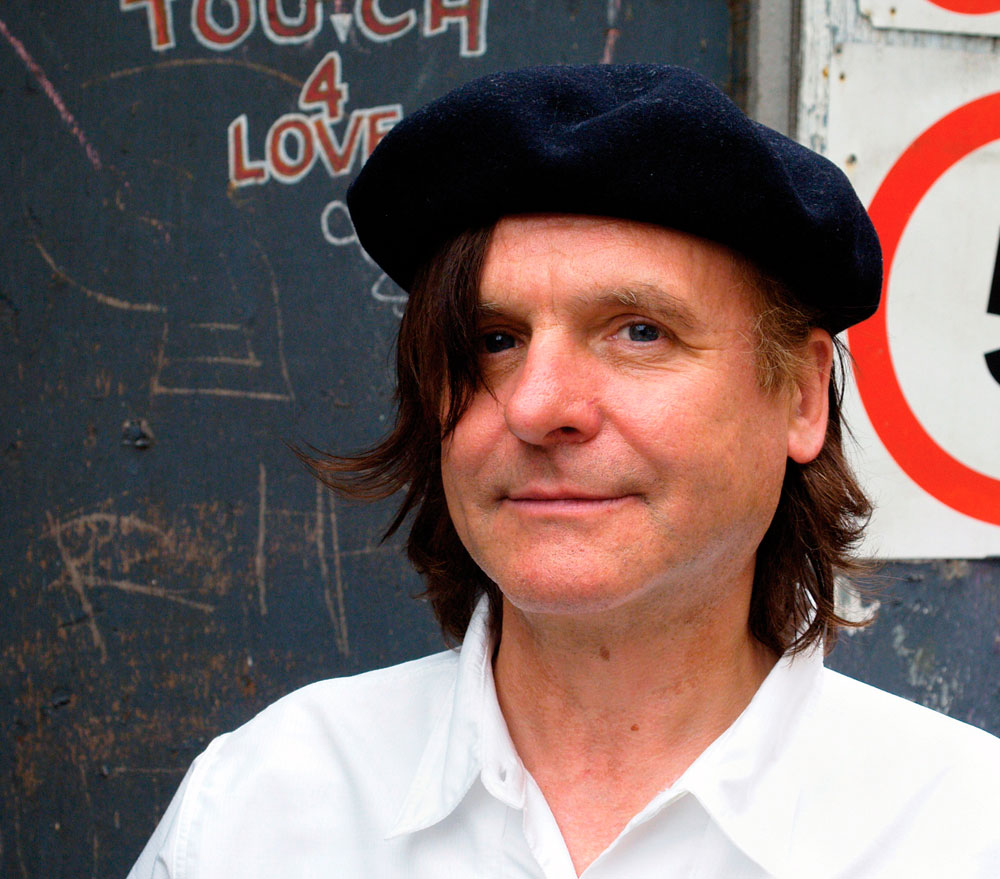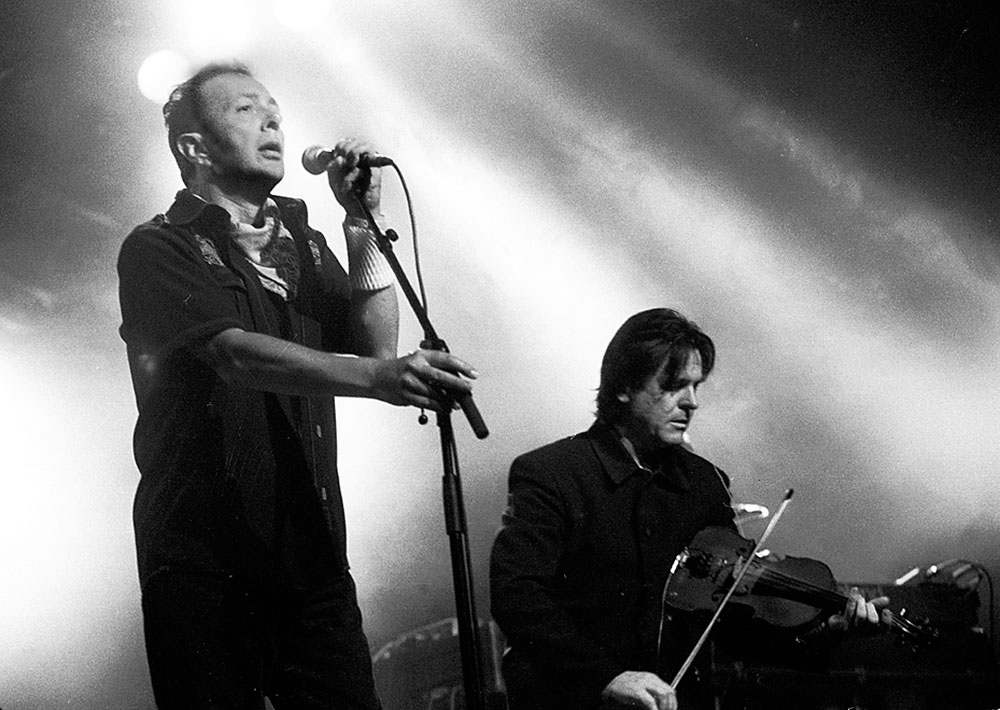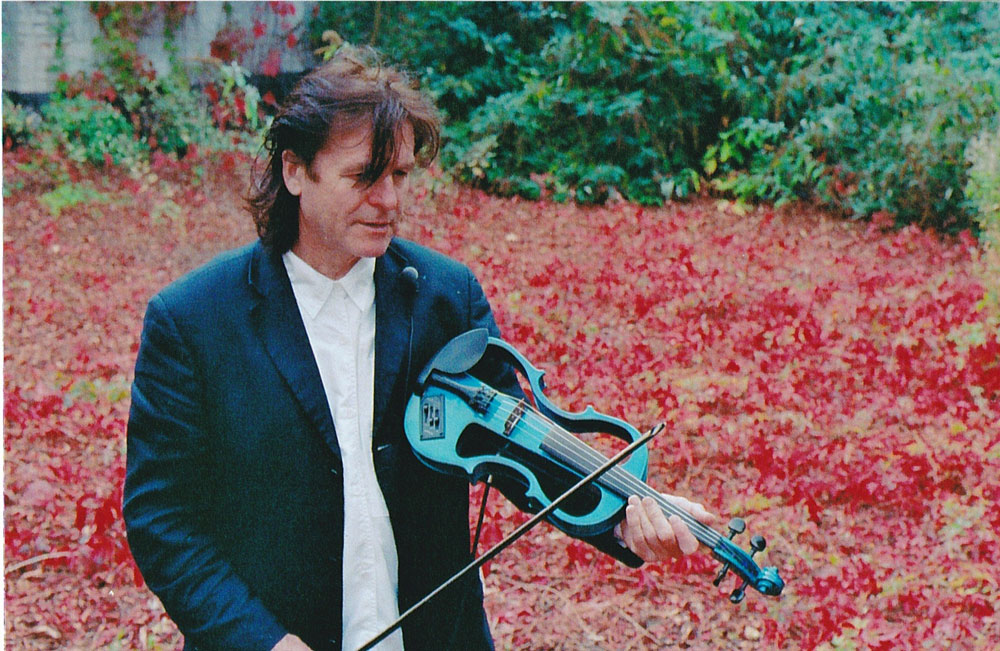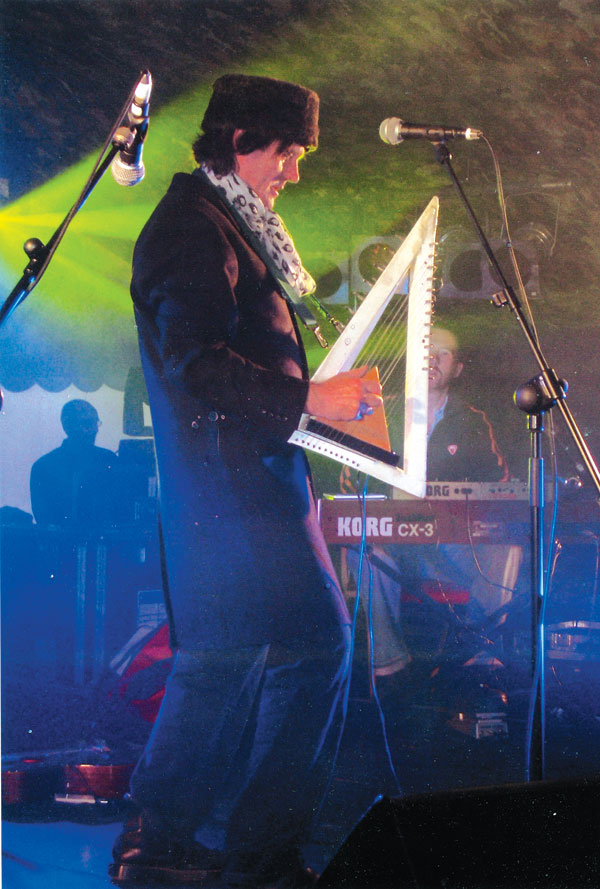Dogg Daze
Not only was he one of the first and wildest fiddlesingers on the block, there ain’t many with a CV that runs from the Cavern to Guantanamo via the Clash. Ian Anderson catches up with Tymon Dogg, one of the few who really does merit being called a great original.
From fRoots 392, November 2007

Photo: Ian Anderson
Somewhere back in the grey early months of this year, Elizabeth Kinder and I were to be found hunched over her kitchen table trying to brainstorm a tenuous link between two notable anniversaries that were looming in 2007 – thirty years since so-called Year Zero when punk rock burst on a bloated music industry, and twenty since the naming of the World Music box in record shops. We never did find one, but it got us thinking about English musicians who had moved sideways from the punk era into the parallel universe chronicled by fRoots. When you start climbing that particular path it leads inexorably to two bands at the very peak, the loveable Mekons, and the late and very lamented Joe Strummer & The Mescaleros.
The Mescaleros’ second album Global A Go-Go is definitely one that’ll be in my Desert Island choices in the unlikely event that I ever get that call from Radio 4. Its inspired blend of Clash-era rock, multicultural roots music and the future marked the solid reunion and magical creativity of two people whose lives had interwined on and off for nearly thirty years – Joe Strummer and Tymon Dogg.
And so I find myself one August lunchtime in an ancient pub near London Bridge, reacquainting myself with one of the true unsung originals of English music, after a break of nearly two decades.
In the early ’70s, Dogg and Strummer first got together in a now legendary squat in Wood Green nicknamed Vomit Heights (see Chris Salecwicz’s Strummer biography Redemption Song for lots more on that era).
Joe was bottling in the undergound for the busking Tymon and learning to play on his ukulele. Strummer was just starting out, but by that time Tymon was already a music business veteran. Those of you familiar with Tymon’s manic fiddle-singing (if you thought that Jon Boden was at the outer reaches of go-for-it vocalising with simultaneous bowing, think again!) might be startled to know that he was once in danger of becoming a fully fledged pop star.
Born in Lancashire, not to a Mr & Mrs Dogg but as Stephen Murray, the youthful Tymon narrowly escaped the clutches of religion at the bidding of Bob Dylan. “At that time I’d sort of gone to a seminary. Then when I was about eleven these older guys came and they were playing Blowin’ In The Wind and stuff like that and I went ‘That’s better, that’s gonna do much more than this spiritual search. That is where it’s going.’ I remember standing in the cloakroom in front of the mirror and I was combing my hair going ‘guitars not bibles’! I must have been fourteen then. I had a guitar my father had bought me when I was seven and I hadn’t really worked out how to play it and I put some strings on and just played it all the time. By the end of that year I tried playing in public in a few places, like youth clubs, stuff like that. I was doing one of them and some band from Liverpool saw us and said ‘Come with us tomorrow night and we’ll get you on The Cavern’. Bob Wooler, you know, who used to manage The Beatles, he was getting me gigs.”

Tymon with Joe Strummer in the Mescaleros, Cambridge Festival 2002. Photo: Jak Kilby
His first single – he was billed in those days as Timon – had Jimmy Page and John Paul Jones among the session players, but vanished with little trace, so a while later he got talent scouted by the Beatles’ company Apple. This time he had Paul McCartney on piano and Peter Asher as producer but things fared little better – they wanted to make him a male Mary Hopkin when he’d rather have been Tom Rush – and he was off again. Third time no more lucky, he signed to the Moody Blues label Threshold and was soon supporting them at the Albert Hall. He was still only nineteen.
Somewhere along the line Tymon picked up violin, which down the years has become the instrument for which he’s best known. At various times he’s quoted influences from Indian and Irish players. But fiddle-singing has not been a common sight out there until fairly recently, and back then there were few role models.

Bracknell Folk Festival, 1989. Photo: Jak Kilby
“Me and Joe, well, they were my gigs and he was roadying for me in 1974. It’s a long story, but when we were hitching back this guy picked us up. We were completely broke and he said ‘I’m putting on a concert tomorrow’ and there was a jazz band, and Barry Dransfield was on. It was a big hall in the middle of Belgium, and the guy said ‘Would you like to play in the foyer?’ So we watched Barry do his gig – I’d never heard of him before – and I was singing and playing the violin, I think Joe was strumming a few chords behind us. After, Barry and I had a bit of a chat. Anyway, this guy put us up in his place and there were other gigs going on where Barry was booked. But the next morning Barry was gone. So the guy said ‘Will you do his gigs for us?’, and I did his gigs for him. So if Barry wonders why he never gets a gig in Belgium…!”
I first met Tymon when he used to regularly show up and do floor spots on our Hot Vultures gigs at the Rising Sun in Tottenham Court Road in the mid ’70s, though it was only in the course of this recent conversation that it dawned on me that the guy who always came with him was the young Joe Strummer. Streuth! “Joe went round all the folk scene, all those places, he was always there. If ever I had a gig in London he was always there.”
That was in the days when we could hardly get arrested in mainstream UK folk clubs (probably because we tended to play everything too fast and too loud!), but Maggie Holland reminds me of a later time when Tymon showed up at a gig we were doing at a North Eastern folk festival. We got him the spot before us and he attacked his violin and the stage with such ferocity, probably showcasing one of his high energy masterpieces like Locks & Bolts & Hinges, that the entire audience rapidly shuffled back about two metres!

Photo credit: tymondogg.com
“I spent quite a bit of time in Spain. I worked with Enrique Morente a bit, and I even did a gig in Madrid with Compay Segundo, playing the violin. There’s two world music records where I’m credited as Step Murray. I had a child and I wanted to look after the child very much, so I put a lot into that. I worked around Ireland quite a bit with a singer-songwriter called Sean Miller. I was doing all kinds of really quite nice things. And then also things were happening in my personal life which sometimes had to be done, like if somebody got sick you’d stand there for them. So there were things like that happening. It was a very magical time. I came back here round about 1999.”
Tymon reconnected with Joe Strummer not long after returning from Spain and they played together at a memorial concert for one of the 101ers. Then, a year later, after the first Mescaleros record had come out and the line-up had disbanded, they met again at the Poetry Olympics. “How Global A Go-Go was done was that Joe called up after the Poetry Olympics and said ‘Let’s do a tour, me, you and a percussionist and Martin Carthy’ (I don’t know if Martin knows this!) because actually Martin played the guitar with us on the Poetry Olympics. I’d introduced them and he got up and played guitar and Joe left the stage and said ‘That’s the most enjoyable bit of singing I’ve ever done in my life’.”
“Joe never worked too much on his own. Whether it was Mick Jones or somebody else, he always wanted to work with other people to do the music. He wasn’t comfortable with music – he loved music but art was his real thing. I’d convinced him way back, not just him but everybody in the house that they could all learn to play the guitar and that the guitar was for everybody. Music was for everybody, like walking. You don’t have to make a living out of walking or running, but it’s still yours and your soul needs it. Music doesn’t have to be a job to be the most important thing in your life. You don’t have to be a prostitute for sex to be the most important thing in your life. You don’t have to be a glutton… anyway, you get the idea. It was that element where he started playing, getting involved in music, but it always needed that catalyst.”

Tymon with his pyramid harp.

The Irrepressible Tymon Dogg CD
Footnote: since this feature was published, Rev-Ola issued the superb compilation CD The Irrepressible Tymon Dogg: A Collection 1968-2009 and Tymon has a new 2015 album Made Of Light. He appeared at Sidmouth Folk Festival 2016 in a double bill with Hot Vultures.
Shop
You can buy CDs and downloads at our online shop.
Writing
Technology (2002)
Photographers (2002)
English Country Dance Music (2003)
Is That All There Is? (2005)
Self Worth (2007)
Television (2008)
Musical Racism (2008)
Small Venues & the Folkistanis (2009)
Existential Stuff Crisis (2013)
Festival Challenge (2014)